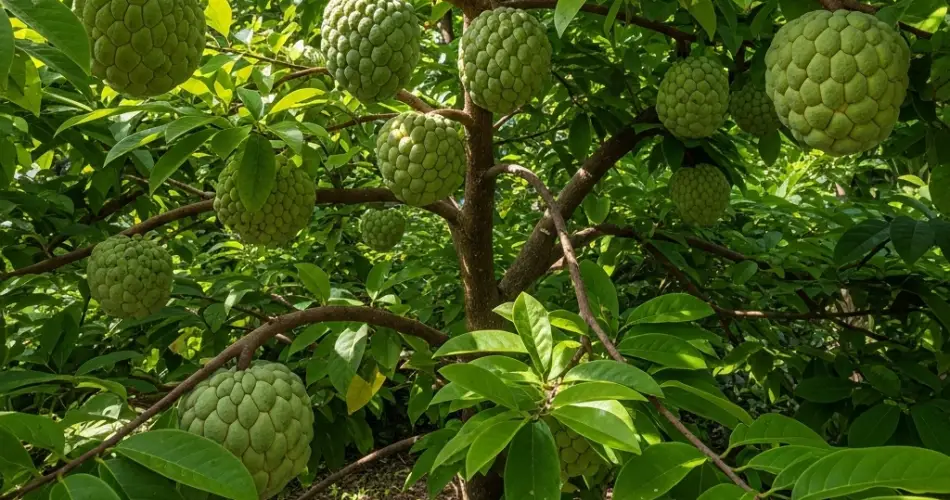Cherimoya (Annona cherimola), often referred to as the “custard apple,” is a tropical fruit renowned for its creamy texture and sweet flavor. Native to the Andean valleys of South America, this fruit has garnered global appreciation. If you’ve ever savored a cherimoya and pondered cultivating your own tree, you’re in luck. With patience and the right techniques, you can successfully germinate cherimoya seeds and nurture them into thriving trees.
Understanding Cherimoya Seeds
Cherimoya seeds are encased in a hard shell, which can make germination a slow process. However, with proper preparation, you can enhance germination rates and speed.
Step-by-Step Guide to Germinating Cherimoya Seeds
1. Extracting and Cleaning Seeds
-
Begin by selecting a ripe cherimoya fruit.
-
Carefully cut the fruit open and remove the black seeds.
-
Rinse the seeds thoroughly under lukewarm water to eliminate any residual pulp, which can inhibit germination.
2. Soaking the Seeds
-
Place the cleaned seeds in a bowl of room-temperature water.
-
Allow them to soak for 24 to 48 hours.
-
This process softens the seed coat, facilitating easier germination.
3. Scarification (Optional but Beneficial)
-
To further assist germination, you can scarify the seeds.
-
Gently rub each seed with fine-grit sandpaper or nick the seed coat with a knife.
-
This allows moisture to penetrate more easily.
4. Germination Methods
a. Paper Towel Method
-
Moisten a paper towel and wring out excess water.
-
Place the seeds on the towel, fold it over them, and insert it into a plastic zip-lock bag.
-
Store the bag in a warm, dark place, maintaining a temperature between 20°C to 25°C (68°F to 77°F).
-
Check periodically for mold and ensure the towel remains moist.
-
Seeds typically germinate within 3 to 5 weeks.
b. Direct Soil Planting
-
Fill small pots with a well-draining potting mix.
-
Plant each seed about 2.5 cm (1 inch) deep.
-
Water thoroughly and place the pots in a warm, sunny location.
-
Maintain consistent moisture without waterlogging.
-
Germination can take 4 to 6 weeks.
Transplanting Seedlings
-
Once seedlings have developed a few sets of true leaves and are approximately 15 cm (6 inches) tall, they can be transplanted.
-
Choose a larger pot or a suitable outdoor location with well-draining soil and ample sunlight.
-
Handle the roots gently to prevent damage.
Caring for Your Cherimoya Tree
1. Sunlight and Temperature
-
Cherimoya trees thrive in full sun but can tolerate partial shade.
-
They prefer temperatures between 18°C to 25°C (64°F to 77°F).
-
Protect young trees from frost and extreme cold.
2. Watering
-
Maintain consistent soil moisture, especially during the growing season.
-
Avoid overwatering, which can lead to root rot.
3. Fertilization
-
Apply a balanced fertilizer (e.g., 10-10-10 NPK) every 3 months during the growing season.
-
Reduce feeding during the dormant winter months.
4. Pruning
-
Prune the tree to maintain shape and remove any dead or diseased branches.
-
This encourages healthy growth and better fruit production.
Pollination and Fruit Production
Cherimoya flowers are hermaphroditic but function as female and male at different times, making natural pollination challenging. Hand pollination increases fruit yield:
-
Collect pollen from male-stage flowers using a small brush.
-
Transfer the pollen to female-stage flowers, which are receptive earlier in the day.
Trees grown from seed may take 3 to 5 years to bear fruit. Note that seed-grown trees can vary in fruit quality compared to grafted varieties.
Potential Challenges
-
Pests and Diseases: Watch for aphids, scale insects, and fungal infections. Treat infestations promptly with appropriate organic or chemical controls.
-
Root Rot: Ensure proper drainage to prevent waterlogged soil, which can cause root diseases.
Conclusion
Growing a cherimoya tree from seed is a rewarding endeavor that brings the taste of the tropics to your backyard. With patience and attentive care, you can enjoy the lush foliage and, eventually, the delectable fruits of your labor.



